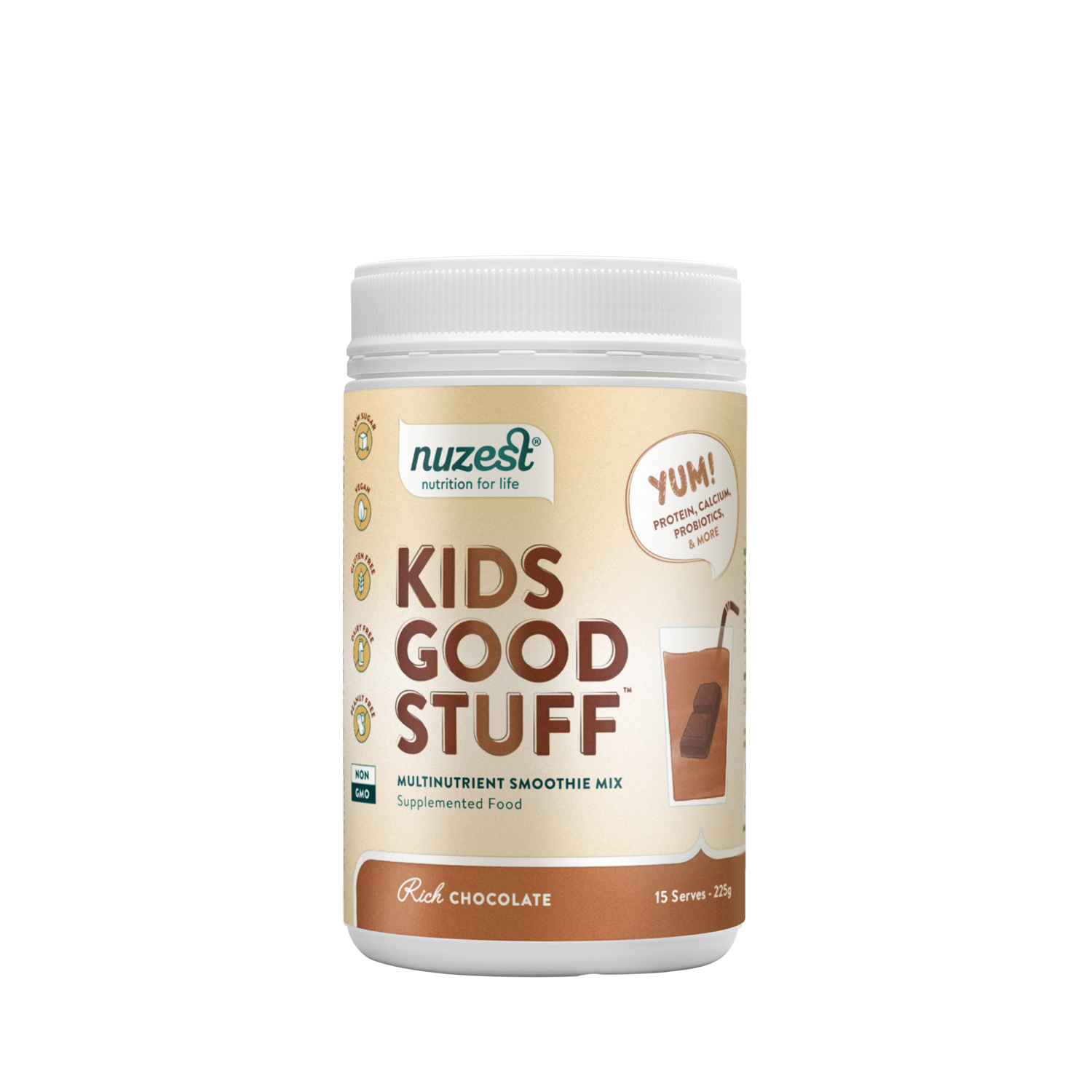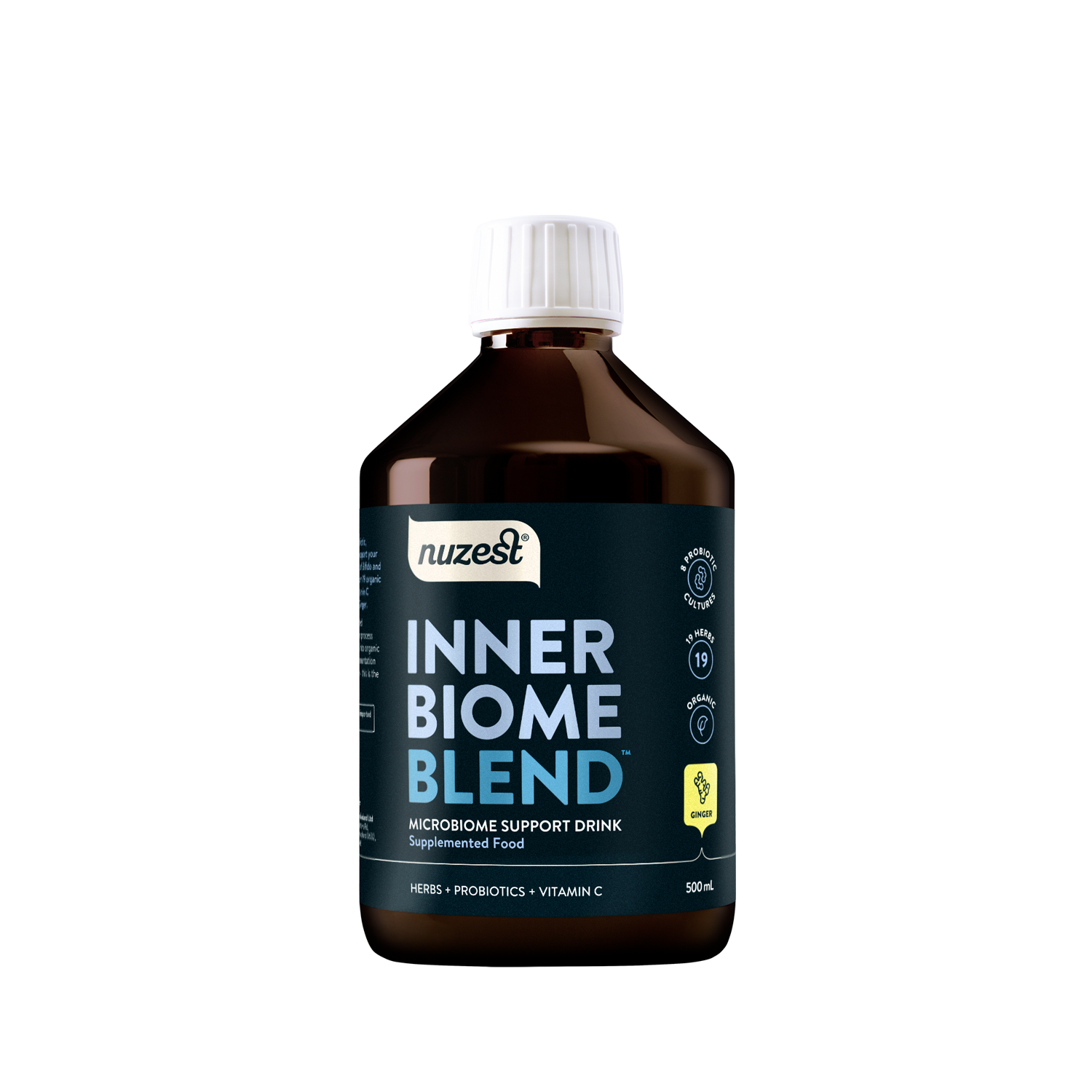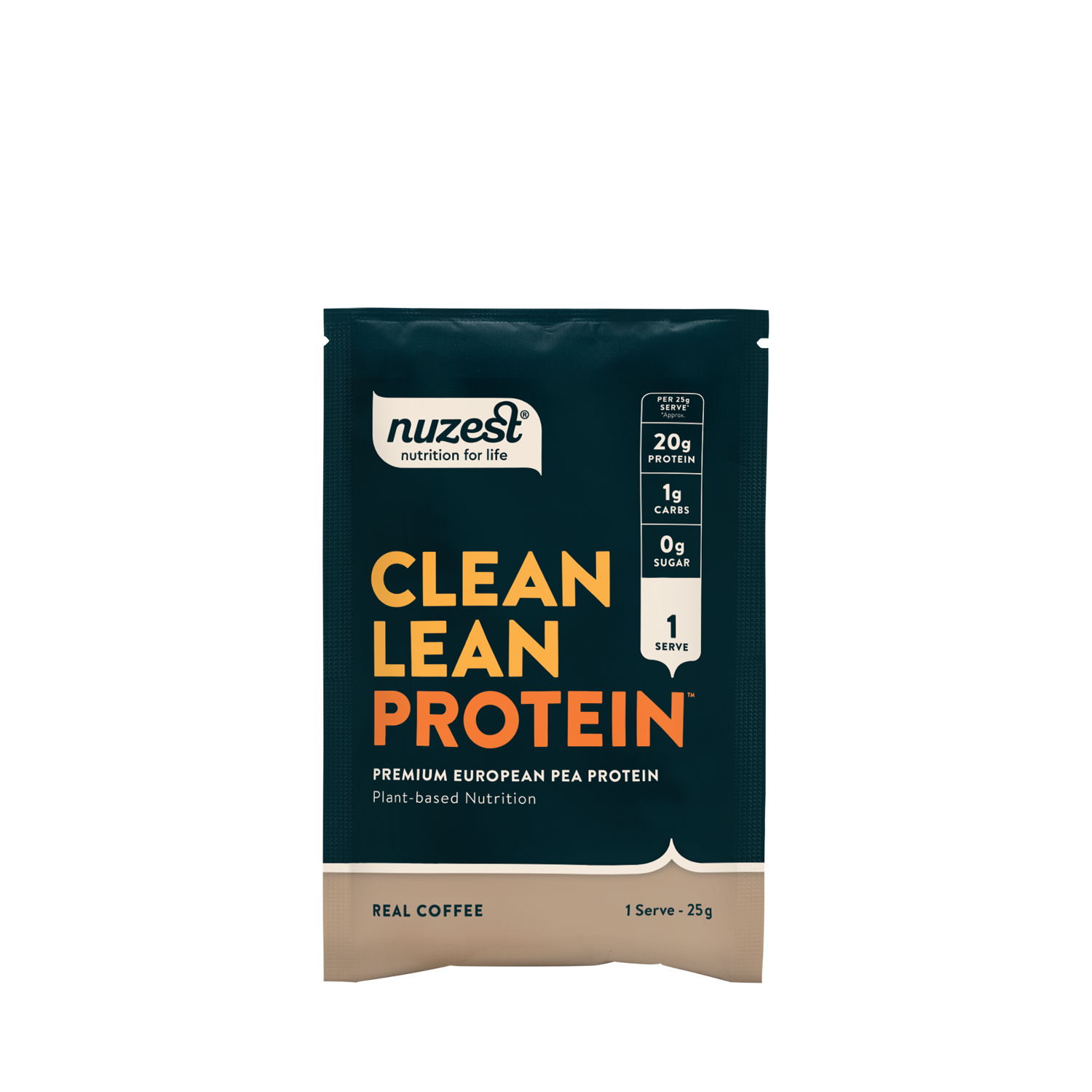Author: Megan Jones (Adv.Dip.NutMed, BHsc.NutMed)
Good dietary choices contribute to quality of life. They also help us maintain a healthy body weight, protect against infection, and reduce the risk of developing chronic conditions such as cardiovascular disease, chronic respiratory disease, cancer and autoimmunity. Conversely, poor dietary choices can lead to reduced immunity and ill health, and are often linked to the development of such conditions.[1]
Good nutrition not only on a day-to-day basis, but throughout the entire lifespan is fundamental - for infants to grow into healthy adults and with subsequent progression through to old age.[2]
Here at Nuzest, our primary focus is nutrition - arguably the cornerstone of a healthy life and particularly when it comes to healthy ageing. It impacts us at every stage, from the moment of conception right through to our golden years, with the unique needs of each life stage influencing our overall health and wellbeing.[3]
Nutritional gaps in the diet across all life stages are common[4] however, and maintaining or increasing diet quality may be difficult throughout the various life stages and for various contributing factors.[5] [6] With this in mind, we have developed our daily highly anti-inflammatory, multinutrient formula Good Green Vitality, containing 75+ whole-food and plant-based ingredients, including vitamins, minerals, herbs, adaptogens and more. We have designed Good Green Vitality not only to help fill these nutritional gaps, but to also support the 11 biological systems within our body.
Both macro and micronutrient gaps have become increasingly common amongst children as well, particularly between ages 4 and 14 [7] [8] [9]. For this reason, we have developed a daily multinutrient formula for the kids too – Kids Good Stuff – a solid foundation of protein, fruits and vegetables with added vitamins, minerals, probiotics and much more.
In this article, we explore the importance of healthy nutrition throughout the life stages, highlighting the significance of making informed dietary choices, including quality supplementation to help fill any gaps.
Key takeaways:
- Good nutrition not only on a day-to-day basis, but throughout the entire lifespan is fundamental in supporting our overall health and wellbeing, from conception right through to our golden years.2
- Nutritional gaps in the diets of both adults and children are common. 4 7 8 9
- Despite humans living longer than ever before, there has sadly been a significant rise in age-related chronic diseases, globally.10
- Optimal nutrition is relevant to every phase of life, starting from pregnancy and extending to the later years of adulthood.
Why focus on ageing healthily?
Our human lifespan is expanding. Over the past century we have seen a rise in life expectancy across all age groups[10]. From when WHO was founded 75 years ago until 2023, the global life expectancy has increased dramatically - from 46 to 73 years.[11] Despite increased longevity however, there has sadly been a significant rise in age-related chronic diseases, globally.[12]
With chronic diseases like heart disease, cancer, chronic respiratory disease, and diabetes now making up 7 of the world's top 10 causes of death,[13] a new initiative and a centred emphasis for progress in the field of healthy ageing has been proposed by WHO, collaborating with the United Nations on their Decade of Healthy Ageing (2021–2030).[14]
According to WHO’s definition, healthy ageing, is “the process of developing and maintaining the functional ability that enables wellbeing in older age”.[15]
With research reporting that adequate physical activity, restorative sleep, and the minimisation of personal risk factors are all critical to a healthy lifespan[16], the impact of nutrition – in and of itself – is of particular focus by WHO.
Since nutritional requirements vary greatly across and within age groups, generic dietary recommendations may not be optimal for everyone. Furthermore, individual variability in nutritional needs is likely to be exacerbated with increasing age, due to the effects of environmental stressors, lifestyle choices and chronic disease.[17]
Read on to discover how nutrition is relevant to every phase of life, starting from pregnancy and extending to the later years of adulthood.
Pregnancy
The journey to good health begins even before birth.[18] During pregnancy, the developing foetus relies entirely on the mother's nutrition for growth and development,[19] which means what we consume while pregnant can not only influence our own health, but it can also affect the short- and long-term health of the baby.
Proper nutrition during this time is crucial for the baby's brain, organs, and overall physical development.[20] Adequate intake of essential nutrients such as folic acid, iron, calcium, and omega-3 fatty acids is vital for the baby's wellbeing.[21] [22]
Infancy & Early Childhood
As infants transition to early childhood, nutrition continues to play a pivotal role.[23] Breastfeeding, known as the gold standard in infant nutrition, provides essential nutrients and antibodies that boost the infant's immune system.[24] Numerous studies highlight the long-term benefits of breastfeeding, including reduced risk of infections, allergies, and obesity.[25]
Complementary feeding helps to introduce the infant to a wide range of new tastes and textures gradually. It can be thought of as a journey, with different tastes and textures gradually introduced over time.[26]
Babies need time to learn about food and develop chewing skills as well as become familiar with the flavours of food,[27] and so the introduction of solid foods should be a carefully planned process. This period establishes a child's palate and dietary preferences,[28] and should include a variety of nutrient-rich foods to promote healthy growth and development.
Childhood (Ages 2-11)
Toddlers and preschool-age children experience rapid growth and development – so it is crucial to ensure they receive adequate energy (calories) and essential nutrients. At this age, kids also acquire knowledge about food and eating which helps them to foster the habit of enjoying a diverse, nutritious diet while in the company of their families.[29]
Unfortunately, globalisation and urbanisation have both negatively impacted the eating patterns of children, with a greater trend observed for the consumption of snacks, meals away from home, fast foods and sugar-sweetened beverages. With this current trend of highly processed foods means lower nutritional density and adverse health consequences.[30]
Different institutions, including the WHO, recommend the establishment of healthy eating habits at an early age as a method to prevent chronic diseases later in life.[31]
Providing kids a balanced and varied diet is crucial, which includes a substantial consumption of fresh fruits, vegetables, and whole foods.[32] Particular attention is also needed towards adequate protein - from sources such as lean meats, eggs, dairy, beans, lentils, nuts, or Nuzest’s Kids Good Stuff, and towards healthy fats like those found in avocados, nuts, seeds, and fatty fish (such as salmon). Also incorporating daily consumption of complex carbohydrates like whole grains (whole wheat bread, brown rice, oats) will mean a nutritionally replete diet for your child, providing necessary nutrients for growth, cognition, development and overall wellbeing.
Adolescence (Ages 13-18)
Through late childhood and early adolescence, nutrition has an influential role in the timing and pattern of puberty. Nutritional deficiencies can lead to negative outcomes affecting adult height, muscle development, and fat mass accrual, as well as risk of chronic disease later in life as well.[33]
In fact, the impact of nutrition in adolescent development actually extends beyond muscle growth, and to cardiovascular and cardiorespiratory health, as well as brain development, and immunity.[34]
Did you know? Nutritional requirements increase dramatically during adolescence and may exceed those of adulthood![35]
Adolescents are prone to imbalances in energy and also dietary deficiencies of protein, calcium, iron, folic acid, and vitamins A, D, E, and B6.35
Zinc is another common nutritional deficiency that presents during adolescence, and its deficiency is linked to impaired attention, learning, and memory, as well as to possible development of neuropsychological diseases.[36] When it comes to skin health, and in particular acne, which is one of the most common health concerns amongst adolescents, research also suggests that zinc supplementation can reduce inflammation and bacterial growth[37]
and has in fact been used extensively both topically and systemically for the management of acne for almost 50 years.[38]
Adulthood (Ages 19-64)
Adulthood is a time when nutrition becomes a key player in maintaining health and preventing chronic disease. Early adulthood is also the period when individuals experience major transitions, including changes in the home and social environment, moving from family dependence to towards stronger peer networks and financial independence. Many of these factors have shown associations with diet and eating behaviours.[39]
Recent research has consistently highlighted the role of a well-balanced diet for adults in reducing the risk of chronic disease, with adequate intake of nutrients such as protein, fibre, antioxidants, and essential fatty acids continuing to be essential.[40] [41]
Specific dietary factors that have been found to be beneficial for healthy aging include adherence to a Mediterranean-style diet, Okinawa diet, Dietary Approaches to Stop Hypertension (DASH) diet, and caloric balance as well as following the healthy eating index.[42]
According to the Dietary Guidelines for Americans adults, a healthy eating plan:
- Emphasises fruits, vegetables, whole grains, and dairy.
- Includes a variety of protein foods such as seafood, lean meats and poultry, eggs, legumes (beans and peas), soy products, nuts, and seeds.
- Is low in added sugars, sodium, saturated fats, trans fats, and cholesterol.
- Stays within daily caloric requirements.[43]
Older adulthood (Ages 64+)
Maintaining a healthy diet in older age can be an effective strategy for preserving optimal health and function. In fact, older adults are particularly vulnerable to compromised nutritional status.[44] The consumption of a high-quality, nutritionally dense diet focussing on adequate intake of protein, fibre, vitamin D, and omega-3 fatty acids is essential for better physical function, bone health, muscle strength and particularly as its gradual decline often leads to ‘sarcopenia’, cognitive function, and a lower risk of chronic diseases and disability.[45]
Proportionally, macronutrient needs for older adults are similar to younger adults, however overall caloric requirements tend to decline with age.[46] Also often declining with age are physical activity levels and food intake - increasing the risk of undernutrition due to the inadequate intake of essential nutrients,[47] and also increasing the likelihood of developing sarcopenia – a condition which involves the loss of muscle and strength that accompanies ageing.
3 top nutrients to support and optimise our nutrition – from the cradle to our golden years:
- Protein - Adequate protein intake is crucial when it comes to healthy ageing. In fact protein is fundamental in maintaining and building lean muscle mass from a very early age and in turn, this muscle strength helps regulate our metabolic health and support a risk reduction when it comes to chronic disease development later in life. Protein can enhance the absorption of certain nutrients, including calcium and iron, which are crucial for bone health and overall wellbeing in older adults. Reaching our daily protein requirements through protein-rich foods like lean meats and poultry, eggs, lentils and legumes help us feel satiated, aiding in weight management and reducing the risk of chronic lifestyle diseases that are associated with weight gain and poor metabolic health. Even just 2 scoops of our Clean Lean Protein will help you to reach your daily protein goals - with each serve providing you with 20g of plant-based European pea protein!
- B vitamins – B vitamins are a group of eight essential nutrients that play key roles in many organs and bodily systems. They are involved in energy metabolism, helping to release energy from carbohydrates, fats, and proteins. Research also shows that B vitamins can help to support our mood and cognition, and reduce our body’s physiological response to stress. B vitamins are particularly important in pregnancy, through adolescence and in older age. We can find B vitamins in foods such as peas, nuts, leafy greens, wholegrains and liver, however for a broad range of B vitamins in significantly high doses to help achieve optimal health, look no further than a simple, daily dose of Good Green Vitality!
- Essential fatty acids (EFAs) - EFAs are vital components of our diet - from preconception to our golden years, due to their profound impact on our overall health. These fats, such as omega-3 and omega-6 fatty acids, are deemed "essential" because our bodies cannot produce them on their own - we must obtain them through our diet. EFAs play a crucial role in various bodily functions, including maintaining healthy cell membranes, supporting brain health, regulating inflammation, and promoting cardiovascular health as well. In infancy and childhood, EFAs are pivotal for brain development and overall growth. As we age, they help maintain cognitive function, reduce the risk of chronic diseases, such as heart disease and arthritis, and support overall vitality. Incorporating sources of EFAs, such as fatty fish, flaxseeds, and nuts, into our diet is a fundamental step in ensuring lifelong health and wellbeing. If you are looking for a simple way to incorporate more EFAs into your diet, just 1 daily serve of Good Green Vitality can help in achieving significantly higher levels, due to the flaxseed, spirulina, red marine algae, kelp and alpha-lipoic acid content.
Older adults often face challenges such as reduced appetite, difficulty chewing, and altered taste perception. Therefore, it becomes crucial to focus on nutrient-dense foods to meet the body's changing needs.
Old age: In elderly persons, some nutrient needs (e.g., vitamin D) increase, while others (e.g., energy and iron) are reduced.

As a key modifiable risk factor for many chronic metabolic diseases, diet holds considerable potential for clinical and population benefit. It is a factor that people of all ages can theoretically change and improve, particularly with the rising prevalence of obesity and cardiometabolic conditions worldwide (Reference Willett, Rockstrom and Loken1). A better understanding of diet and its malleability could point the way to more effective interventions targeting obesity and metabolic diseases (Reference Gasser, Kerr and Mensah2).
Early childhood: Recognition of the importance of nutrition in the first 1000 d has led to growing interest in the tracking of diets during early life.
children experience significant developmental shifts in diet selection during early childhood, where ages from 2 to 6 years are peak ages for the development of food neophobia (Reference Scaglioni, De Cosmi and Ciappolino16).
Adolescent to young adulthood:
Poor diet quality is common during adolescence and has been linked with the early onset of chronic disease risk factors such as obesity and a high abdominal waist circumference.
Using latent growth curve models, fruit and vegetable intakes were observed to decline from the age of 14 years to the age of 23 and 21 years, respectively, before increasing to the age of 30 years.
Mid to late adulthood:
By mid-adulthood, eating and lifestyle habits are set in place and any modifications would likely to be more challenging to enforce (Reference Todd, Street and Ziviani21).
References:
- https://www.aihw.gov.au/getmedia/5fc6d6be-dcec-458e-af63-2e6c90589bd8/Nutrition-across-the-lifestages-in-brief-aihw-phe-227.pdf.aspx
- https://www.ncbi.nlm.nih.gov/pmc/articles/PMC7550962/
- https://www.ncbi.nlm.nih.gov/pmc/articles/PMC6356123/
- https://www.ncbi.nlm.nih.gov/pmc/articles/PMC9710417/
- https://www.ncbi.nlm.nih.gov/pmc/articles/PMC2935122/
- https://www.ncbi.nlm.nih.gov/pmc/articles/PMC6064642/
- https://www.ncbi.nlm.nih.gov/pmc/articles/PMC6571436/
- https://pubmed.ncbi.nlm.nih.gov/35807863/
- https://www.ncbi.nlm.nih.gov/pmc/articles/PMC4023304/
- https://www.ncbi.nlm.nih.gov/pmc/articles/PMC4861644/
- https://www.who.int/director-general/speeches/detail/who-director-general-s-opening-remarks-at-shaping-the-future--rebooting-multilateralism---20-september-2023
- https://pubmed.ncbi.nlm.nih.gov/23232660/
- https://www.who.int/news/item/09-12-2020-who-reveals-leading-causes-of-death-and-disability-worldwide-2000-2019
- https://www.who.int/initiatives/decade-of-healthy-ageing
- https://www.who.int/news-room/questions-and-answers/item/healthy-ageing-and-functional-ability
- https://www.ncbi.nlm.nih.gov/pmc/articles/PMC7550962/
- https://www.ncbi.nlm.nih.gov/pmc/articles/PMC7550962/
- https://www.ncbi.nlm.nih.gov/pmc/articles/PMC9640361/
- https://www.ncbi.nlm.nih.gov/pmc/articles/PMC4949006/
- https://www.ncbi.nlm.nih.gov/pmc/articles/PMC4981537/
- https://www.ncbi.nlm.nih.gov/pmc/articles/PMC7926714/
- https://pubmed.ncbi.nlm.nih.gov/25076770/
- https://www.ncbi.nlm.nih.gov/pmc/articles/PMC5331538/
- https://pubmed.ncbi.nlm.nih.gov/27336781/
- https://www.ncbi.nlm.nih.gov/pmc/articles/PMC3508512/
- https://www.nutrition.org.uk/life-stages/baby/introducing-solid-foods-to-your-baby/
- https://www.ncbi.nlm.nih.gov/pmc/articles/PMC5331538
- https://www.ncbi.nlm.nih.gov/pmc/articles/PMC5524770/
- https://pubmed.ncbi.nlm.nih.gov/35057552/
- https://pubmed.ncbi.nlm.nih.gov/31078365/
- https://pubmed.ncbi.nlm.nih.gov/35057552/
- https://www.ncbi.nlm.nih.gov/pmc/articles/PMC8067332/
- https://pubmed.ncbi.nlm.nih.gov/34856190/
- https://www.thelancet.com/journals/lancet/article/PIIS0140-6736(21)01590-7/fulltext
- https://www.sciencedirect.com/science/article/abs/pii/S0025712516372960?via%3Dihub
- https://www.ncbi.nlm.nih.gov/books/NBK525242/
- https://www.ncbi.nlm.nih.gov/pmc/articles/PMC9785331/
- https://www.ncbi.nlm.nih.gov/pmc/articles/PMC4120804/
- https://www.cambridge.org/core/journals/british-journal-of-nutrition/article/dietary-trajectories-through-the-life-course-opportunities-and-challenges/1EE5008166B0647488E35B1FF508DAB5
- https://www.ncbi.nlm.nih.gov/books/NBK554545/
- https://www.ncbi.nlm.nih.gov/books/NBK562207/
- https://www.sciencedirect.com/science/article/abs/pii/S0047637414000037
- https://www.cdc.gov/healthyweight/healthy_eating/index.html
- https://pubmed.ncbi.nlm.nih.gov/29031341/
- https://pubmed.ncbi.nlm.nih.gov/37191867/
- https://pubmed.ncbi.nlm.nih.gov/29031341/
- https://pubmed.ncbi.nlm.nih.gov/36437020/











